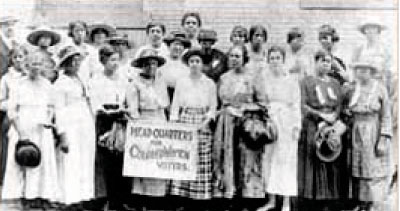Black Women & The Suffrage Movement: 1848-1923
“There is no slave, after all, like a wife...Poor women, poor slaves… All married women, all children and girls who live in their father’s house are slaves.” ~ Mary Boykin Chesnut, A Diary from Dixie, 1861
When Woodrow Wilson arrived in Washington, D.C. on March 3, 1913, he expected to be met by crowds of people welcoming him for his inauguration as United States President the next day. But very few people came to meet his train. Instead, hundreds of thousands of people lined Pennsylvania Avenue to watch a Woman Suffrage Parade.
 |
To demand their right to vote, five thousand women had united under the leadership of suffragist, Alice Paul, and marched through Washington on the day that would give maximum exposure to their cause.
Women demanded suffrage as early as 1848. The Seneca Falls convention in July of 1848, brought together two hundred women and forty men, including feminists Elizabeth Cady Stanton and Lucretia Mott, to make the claim for full citizenship. The delegates believed women to be citizens not limited in any way to their roles as wives or mothers. In the language of the founding fathers, they wrote, “We hold these truths to be self-evident that all men and women are created equal.” They rejected Victorian domesticity and its separation of women and men into private and public spheres, respectively. It was at Seneca Falls that the suffrage movement first began.
As the movement progressed, others spoke loudly, including Susan B. Anthony, who stated, “I will cut off this right arm of mine before I will ever work or demand the ballot for the Negro and not the woman.” White and Black women fought among and between themselves over the best course of action. Sojourner Truth, who had already experienced her own personal struggle toward freedom from slavery, remained unwavering in her support of women’s rights. In her unique way, Sojourner commented on the issue in 1867, when female suffrage was still very much being debated: “I feel that I have the right to have just as much as a man. There is a great stir about colored men getting their rights, but not a word about the colored women; and if colored men get their rights, and colored women not theirs, the colored men will be masters over the women, and it will be just as bad as it was before.”
The Fifteenth Amendment passed in 1870, without reference to sex as a protected category. Exhausted and embittered from the debate, members of the American Equal Rights Association split into two separate factions, the National Woman Suffrage Association (NWSA) and the American Woman Suffrage Association (AWSA). The vast majority of American women, Black and White, did not belong to either organization. They seemed to accept society’s claim that they truly were apolitical beings and belonged not in the voting booth, but at home, taking care of their families. Some housewives even denounced female suffrage, claiming that if women were to vote differently from their husbands, domestic unrest would surely follow.
During the last quarter of the nineteenth century, White and Black women, however, did return to their role as social reformers. The largest and best known was the Woman’s Christian Temperance Union, (WCTU) founded in 1874. Their policies encouraged separate Black and White unions, but at least one White woman, Amelia Bloomer, campaigned against racism within the movement, and some Black women did rise to positions of prominence. Frances Harper, for one, was most effective in recruiting Black women to the cause and was eventually appointed to the national office.
Among Black women who were staunch suffragists was Anna Julia Cooper, best known for her statement: “Only the BLACK WOMAN can say when and where I enter in the quiet undisputed dignity of my womanhood, without violence or special patronage; then and there the whole Negro race enters with me.” Cooper was particularly effective in emphasizing to Black women that they required the ballot to counter the belief that “Black men’s” experiences and needs were the same as theirs.
Despite the racial divisions, Black women were collective in their courage in the fight for equality. Ida B. Wells-Barnett, the journalist who led an anti-lynching campaign in the late nineteenth century, organized the Alpha Suffrage Club among Black women in Chicago and brought members with her to participate in the 1913 suffrage parade in Washington, D.C. The organizers of the march asked that they
 |
walk at the end of the parade. She tried to get the White Illinois delegation to support her opposition of this segregation, but found few supporters. They either would march at the end or not at all. Ida refused to march, but as the parade progressed, Ida emerged from the crowd and joined the White Illinois delegation, marching between two White supporters. She refused to comply with the segregation.
Excerpts taken from One of Divided Sisters: Bridging the Gap Between Black and White Women by Midge Wilson & Kathy Russell, Anchor, 1996— and PBS.org







